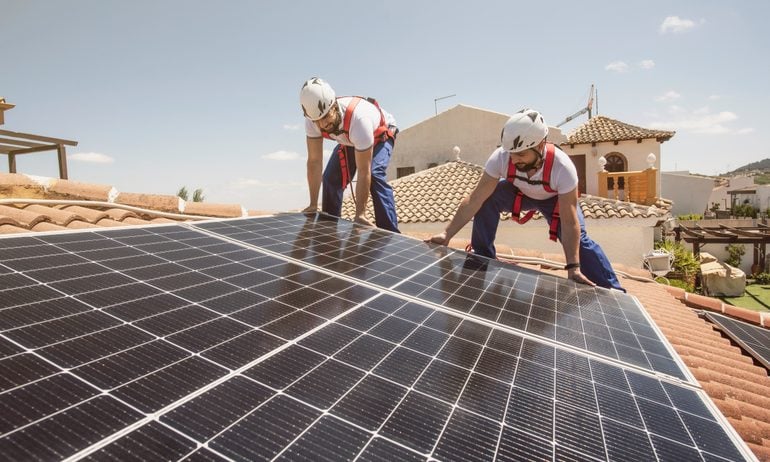Home Improvement Tax Credits and Rebates for Energy Efficiency in 2025
Home improvement tax credits are available for energy-saving home updates, and states offer rebates as well.

Some or all of the mortgage lenders featured on our site are advertising partners of NerdWallet, but this does not influence our evaluations, lender star ratings or the order in which lenders are listed on the page. Our opinions are our own. Here is a list of our partners.
The Inflation Reduction Act of 2022 included tax credits and rebates for homeowners who make energy-saving updates to their homes. Credits for improvements like new solar panels, windows, doors and air conditioners are available now, while rebates for larger energy-efficient updates are available in some states and upcoming in others .
Here’s what to know about these perks, plus tips to plan your projects.
Home improvement tax credits for smaller updates
What you can get:
A 30% tax credit for some energy-efficient updates, capped at $1,200 per year.
A $2,000 credit for heat pumps, heat pump water heaters and biomass stoves or boilers.
You can claim both (up to $3,200) if you qualify.
How it works: The IRA includes tax credits for around-the-house eco-friendly updates. Eligible purchases include energy-efficient windows, doors, insulation, central air conditioners and home energy audits. There are caps on the credit for certain types of purchases:
$600 for any item of qualified energy property.
$600 for exterior windows and skylights.
$250 for an exterior door ($600 in total for exterior doors).
$150 for home energy audits.
An IRS fact sheet outlines eligible home improvements.
Tax credits reduce your tax liability for the year, says Los Angeles-based certified public accountant Michael DiBernardo. For example, a $500 credit lowers your taxes owed by $500.
Make the most of it: Combining projects — like new insulation and a heat pump — can get you up to $3,200, says Kara Saul Rinaldi, president and CEO of the energy and environmental strategy firm AnnDyl Policy Group and an advocate of policies that helped shape the IRA.
Keep receipts for each eligible update and add them to your tax forms, Saul Rinaldi says.
Starting in 2025, you can only claim these credits for equipment made by am IRS-deemed "qualified manufacturer." These manufacturers have an agreement with the IRS to put product identification numbers on their equipment and report the PINs to the IRS. You have to include each item's PIN on your tax return in order to get the tax credits.
Tax credits for solar panels
What you can get: Homeowners can get a tax credit of 30% of the total cost to buy and install solar panels until 2032, after which the tax credit is lower.
How it works: The solar tax credit is only available the year you install the panels, and there’s no dollar limit. So if you pay $15,000 to put solar panels on your house, you may be able to claim a $4,500 tax credit.
Any unused credit carries to future years, so if you don’t owe taxes this year, you may be able to use it later.
Make the most of it: The tax credit will reduce the cost of going solar, but if your goal is to lower your utility bill, first determine when you’ll see savings, which depends on how much you currently pay.
The average payback period for solar panels is five to 15 years, according to the Center for Sustainable Energy, a policy and research firm .
Rebates to generate big savings — eventually
What you can get: There are two notable rebates for energy efficiency. One is a rebate of up to $8,000 for retrofit projects that lead to energy savings. The other is a rebate of up to $14,000 for new electric appliance purchases.
How it works: Low- to moderate-income households — those with total annual incomes of less than 80% of their surrounding area’s median — will be eligible for larger rebates than those with higher incomes.
Even if you don’t usually owe taxes and can’t use the IRA credits, the rebates mean you can still get a discount on energy-efficient updates, Saul Rinaldi says.
Not all states currently offer the IRA rebate program; you can check your state’s progress on the Department of Energy website.
Make the most of it: In some states, it may be months before homeowners can get a rebate. In the meantime, consider a home energy audit to determine which projects to start once the rebates are available. Then work the savings into home improvement plans for this year and next, Saul Rinaldi says.
The North Carolina Clean Energy Technology Center manages a database of state and local incentives that includes resources such as solar installation rebates and low-interest loan programs.
Can I get financing for a home repair or improvement?
Your contractor may offer some financing options (either through a partner or a payment plan), but there are other — any maybe better — financing options available.
Which financing option is best for me?
The best financing option for you will depend on how much money you need, when you need the money, what project you’re doing and how long you need to pay the money back. If it’s something that’ll add value to your home, a HELOC or home equity loan may be your best option because the value of your house could increase by more than the amount of the loan.
On the flip side, if it’s a less expensive repair, a credit card is probably your best option if you want to pay no interest or earn rewards. Personal loans can apply to both small and large repairs or renovations, and they may make sense if you don’t have much equity in your home.
Some home improvement contractors offer their own financing options. Before taking this option, shop around and see how their offer compares with other loans.
Regardless of what you choose, make sure you compare interest rates, terms and fees with any financing options you’re considering. This will ensure you get the best deal.
This article was written by NerdWallet and was originally published by The Associated Press.




